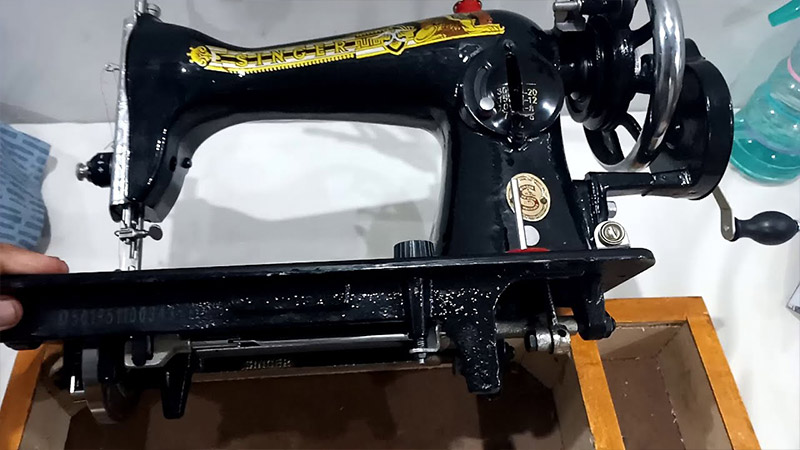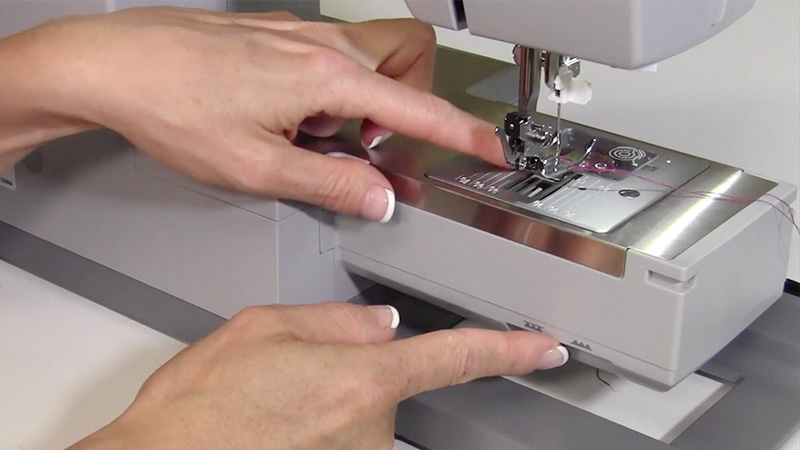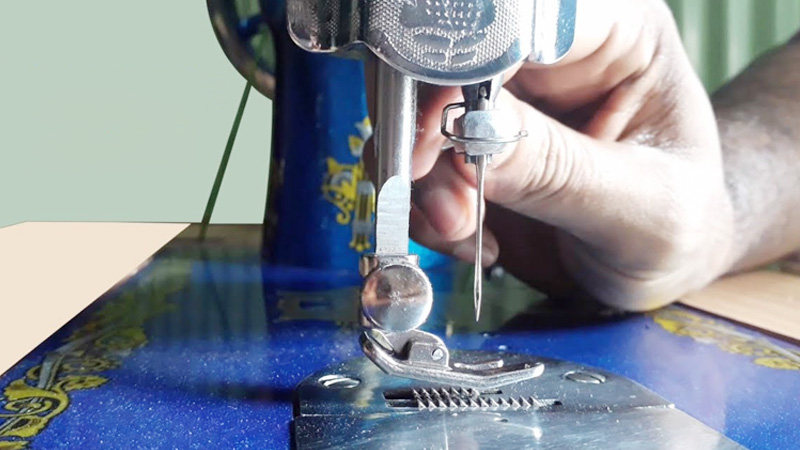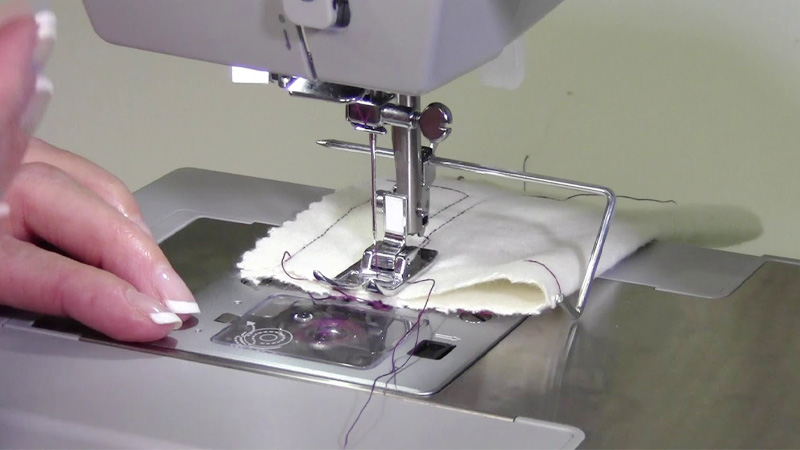Sewing, a beloved craft and practical skill, can become a source of immense frustration when the fabric refuses to cooperate.
The rhythmic flow of the needle and the seamless glide of the fabric are essential for creating beautiful and precise stitches.
Yet, there are instances where the fabric seems to have a mind of its own, resisting the gentle pull of the sewing machine’s feed dogs, leaving you with uneven seams, puckered material, and an exasperated sigh.
Understanding why your fabric won’t move while sewing is crucial for resolving this issue and achieving the smooth, effortless stitching that makes sewing a true delight.

Why Won’t My Fabric Move When Sewing? -Causes & Fixes
When your fabric isn’t moving smoothly when you’re sewing, it can be frustrating and lead to uneven stitches and other sewing woes.
There are several common reasons why fabric might not move as it should while sewing, and understanding these issues can help you troubleshoot and resolve the problem.
Here are some of the most common causes:
Dull Needle
Cause: A dull needle can not only affect the fabric’s movement but also result in uneven stitches and snags. Make it a habit to change your sewing machine needle regularly, especially after a significant project or when switching between fabric types.
Fix: Ensure you’re using the right type of needle for your fabric, as finer fabrics require finer needles, and heavier fabrics need stronger ones.
Thread Tension
Cause: Incorrect thread tension can lead to various sewing issues, including fabric drag. The upper and lower threads should work together evenly to create a balanced stitch.
Fix: Adjust the tension settings based on your fabric type, and remember to always test on a scrap piece of fabric before starting your project.
Presser Foot Pressure
Cause: Not all sewing machines offer this feature, but if yours does, it can be a valuable tool for controlling fabric feed. High presser foot pressure can cause resistance, making it challenging for the fabric to move, while low pressure might not provide enough control for stitching.
Fix: Find the right balance according to your fabric thickness and texture.
Machine Speed
Cause: Sewing too fast can make it difficult to control the fabric’s movement. Slow down, especially when working on curves, corners, or intricate details. If your machine has speed control, use it to your advantage.
Fix: Gradually increase your sewing speed as you become more comfortable with the fabric you’re working on.
Fabric Type
Cause: Each fabric type behaves differently.
Fix: Delicate and slippery fabrics like silk or chiffon may benefit from a walking foot attachment, which helps feed the fabric evenly. On the other hand, heavy fabrics such as canvas or denim might require a denim or jeans needle to penetrate smoothly.
Presser Foot Type
Cause: The right presser foot can significantly affect your sewing experience. For example, a Teflon or non-stick foot is ideal for fabrics that tend to stick or drag, like leather or vinyl.
Fix: Many sewing machines come with a variety of presser feet for different purposes, so explore your options to find the one that suits your fabric.
Machine Maintenance
Cause: A well-maintained machine is crucial for smooth fabric movement.
Fix: Regularly clean the feed dogs, remove lint buildup, and oil the necessary parts following your machine’s manual. A clean and well-lubricated machine will ensure proper feeding and stitching.
Uneven Fabric Layers
Cause: When sewing seams or joining multiple layers of fabric, ensure that the layers are even.
Fix: Pinning or using fabric weights can help prevent one layer from moving faster than the other, resulting in an even seam.
Bobbin Issues
Cause: Problems with the bobbin can disrupt fabric movement.
Fix: Ensure that the bobbin is correctly wound and inserted according to your machine’s instructions. Properly threaded bobbins with balanced tension are essential for smooth sewing.
Sticky Residue
Cause: Sometimes, residue from starch, adhesives, or lint can accumulate on the feed dogs, causing fabric to drag.
Fix: Regularly clean the feed dogs and the surrounding area with a soft brush or lint roller to prevent this issue. Proper cleaning can make a significant difference in fabric feed.
Sewing Machine Feed Dogs Not Moving Fabric -Causes & Fixes

Sewing machine feed dogs not moving the fabric can be a frustrating issue for any seamstress or sewist.
The feed dogs are responsible for advancing the fabric smoothly through the sewing machine, ensuring even stitches and consistent seam allowances.
When they don’t function properly, it can lead to uneven stitches, fabric bunching, or even the fabric not moving at all.
Here, we’ll explore the common causes and their respective fixes:
Feed Dogs Dropped or Disengaged
- Causes: Most sewing machines have a feed dog control that allows you to lower or disengage the feed dogs for free-motion or darning work. If they’re accidentally lowered or disengaged, they won’t move the fabric.
- Fix: Consult your sewing machine’s manual to learn how to re-engage or raise the feed dogs. This typically involves flipping a switch or button.
Lint and Debris Buildup
- Causes: Lint, thread fragments, and other debris can accumulate in the area around the feed dogs, causing them to become sluggish or nonfunctional.
- Fix: Regularly clean your sewing machine, particularly the feed dog area. Use a soft brush, compressed air, or a lint roller to remove debris. Maintenance should include oiling your machine according to the manufacturer’s recommendations.
Feed Dogs Worn or Damaged
- Causes: Over time, feed dogs can become worn or damaged, resulting in decreased performance.
- Fix: If your feed dogs are seriously worn or damaged, it’s best to consult a sewing machine technician for repair or replacement. In some cases, replacing the feed dogs is a relatively straightforward task if you have some experience with sewing machine repair.
Feed Dog Timing
- Causes: Sewing machines have a precise timing mechanism that ensures the feed dogs rise at the right moment to engage with the fabric. If this timing is off, the feed dogs may not move the fabric as they should.
- Fix: Timing adjustments should be performed by a professional sewing machine technician. Attempting to adjust the timing yourself can lead to further issues.
Incorrect Stitch Length
- Causes: If your stitch length is set to zero or a very small value, the feed dogs may not have enough movement to advance the fabric.
- Fix: Adjust the stitch length to a suitable setting, typically between 2 and 3, depending on your sewing machine and the type of stitch you’re using.
Tension Disk Issues
- Causes: Issues with the upper thread tension or the tension disks can also affect how the feed dogs operate, as it can prevent the fabric from moving smoothly.
- Fix: Ensure the upper thread is correctly threaded through the tension disks and the machine. Consult your sewing machine manual for guidance on proper thread tension settings.
Bobbin Case Issues
- Causes: Problems with the bobbin or the bobbin case can cause tension issues and affect the operation of the feed dogs.
- Fix: Check the bobbin and bobbin case for any signs of damage or incorrect installation. Make sure the bobbin is wound correctly and inserted as per your machine’s instructions.
Inadequate Pressure on Presser Foot
- Causes: If there isn’t enough pressure on the presser foot, the fabric may not make proper contact with the feed dogs.
- Fix: Adjust the presser foot pressure according to your sewing machine’s instructions to ensure it provides adequate grip on the fabric.
Sewing Machine Needle Not Moving -Causes & Fixes

A sewing machine needle not moving can be a frustrating problem, as it halts your sewing project completely.
To resolve this issue, it’s important to understand the potential causes and apply the appropriate fixes. Here are some common causes and their corresponding solutions:
Causes:
Machine Not Threaded Correctly
- Causes: If the upper thread is not properly threaded through the machine, it can prevent the needle from moving.
- Fix: Re-thread the machine following the threading instructions provided in your sewing machine manual. Ensure the thread is correctly seated in the tension discs, take-up lever, and all guides.
Tangled or Snagged Thread
- Causes: A tangled or snagged thread can cause the needle to jam and prevent it from moving.
- Fix: Carefully remove any tangled thread from the bobbin area and the needle. Check the bobbin for any snags or knots and rewind it if necessary.
Needle is Bent or Damaged
- Causes: A bent or damaged needle can’t penetrate the fabric properly, leading to it not moving.
- Fix: Replace the needle with a new one. Ensure that you’re using the correct needle type and size for the fabric you’re sewing.
Needle Not Properly Inserted
- Causes: If the needle is not fully inserted or is inserted facing the wrong way, it won’t move correctly.
- Fix: Remove and reinsert the needle, making sure it’s inserted fully with the flat side facing the back and tightened securely.
Presser Foot Not Lowered
- Causes: Some sewing machines won’t operate if the presser foot is not lowered. This safety feature prevents the needle from moving when it shouldn’t.
- Fix: Lower the presser foot before attempting to sew. Ensure it’s securely in the down position.
Bobbin Winding or Placement Issues
- Causes: Problems with the bobbin, such as improper winding or incorrect placement, can affect the needle’s movement.
- Fix: Wind the bobbin correctly according to your sewing machine’s instructions and ensure it’s inserted properly into the bobbin case.
Thread Tension Problems
- Causes: Incorrect thread tension can cause the upper thread to become too tight or too loose, resulting in the needle not moving smoothly.
- Fix: Adjust the thread tension to the appropriate setting for your fabric and thread. Consult your sewing machine manual for guidance on tension adjustment.
Feed Dogs Not Engaged
- Causes: When the feed dogs are disengaged or lowered for free-motion sewing, the fabric won’t be pulled through the machine, which can make it seem like the needle isn’t moving.
- Fix: If you intend to do regular sewing, make sure the feed dogs are engaged. Refer to your machine’s manual for instructions on how to raise the feed dogs.
Mechanical Issues
- Causes: Mechanical problems within the sewing machine, such as a malfunctioning clutch, timing issues, or worn out parts, can also prevent the needle from moving.
- Fix: For mechanical issues, it’s best to consult a professional sewing machine technician who can diagnose and repair the problem.
Electrical or Power Problems
- Causes: If your sewing machine is not receiving power or there’s an electrical issue, the needle may not move.
- Fix: Check the power source, power cord, and any fuses or circuit breakers. Ensure that your sewing machine is properly plugged in and that the power switch is turned on.
Tips for Ensuring Smooth Fabric Movement

Ensuring smooth fabric movement is essential for achieving neat and precise stitches in sewing.
Here are some tips to help you maintain a smooth flow while sewing:
Proper Thread Tension
Achieving the correct thread tension is vital. Too tight can cause puckering, while too loose can result in loose stitches. Experiment and adjust your machine’s tension settings to match the fabric you’re working with.
Use the Right Needle
Selecting the right needle is crucial. Needles come in various types and sizes, designed for different fabrics and purposes.
Refer to your sewing machine’s manual or consult a needle guide to choose the appropriate one.
Quality Thread
Invest in good-quality thread to minimize breakage and fraying. Cheap or old thread can cause sewing issues. Opt for thread that matches the fabric in both weight and color.
Thread Guides and Bobbin
Double-check that your upper thread is correctly threaded through all the thread guides and tension discs.
A missed guide can disrupt the thread’s tension and cause fabric movement issues. Ensure your bobbin is wound evenly and placed correctly in the bobbin case.
Feed Dogs
Ensure the feed dogs are engaged and moving smoothly. If your machine allows for feed dog pressure adjustment, use it to accommodate different fabric thicknesses.
Presser Foot Pressure
Adjust the presser foot pressure to match your fabric. Light fabrics may require less pressure to prevent stretching, while heavy materials need more pressure to prevent slipping.
Stitch Length
Use an appropriate stitch length. Shorter stitches work well with lightweight fabrics to prevent puckering, while longer stitches are suitable for heavy fabrics for added strength.
Pin and Align
Take your time to pin your fabric layers accurately. Proper alignment and pinning help prevent distortion and uneven feeding. Aligning the edges precisely prevents one layer from advancing faster than the other.
Start and Stop Slowly
Gradually start and stop sewing to prevent abrupt movements that can lead to fabric slipping or bunching. This is especially important when sewing delicate or intricate sections.
Machine Maintenance
Regularly clean your sewing machine, including the feed dog area. Proper lubrication, following your machine’s manual, ensures that parts move smoothly for consistent fabric feed.
Walking Foot or Specialty Foot
Consider using a walking foot for challenging fabrics, as it aids in even feeding. Specialty presser feet, such as a Teflon foot for slippery materials, can also help achieve smoother fabric movement.
Stabilizers
Use stabilizers when working with fabrics that tend to stretch or fray, such as knits or lightweight materials. Stabilizers add support and help maintain even fabric movement.
Practice and Patience
Becoming proficient in sewing takes practice. Experiment with different fabrics, techniques, and sewing speeds to gain a better understanding of how fabric moves under your machine’s needle.
Guiding Fabric
Use your hands to gently guide the fabric, ensuring it feeds evenly. Avoid pulling or stretching the fabric, as this can lead to irregular stitches and tension issues.
Sewing Speed
Control your sewing machine’s speed to match the fabric and task at hand. Slow down for precise work and complex patterns, and increase speed for long, straight seams. Mastering the balance between speed and control is key to smooth fabric movement.
FAQS
What should I do if my sewing machine won’t feed fabric properly?
If your sewing machine won’t feed fabric, check for issues like improperly threaded needles, tangled threads, or damaged needles. Ensure the presser foot is lowered, and your feed dogs are engaged.
Why won’t my sewing machine’s needle move when I press the pedal?
If the needle isn’t moving, first verify that your sewing machine is plugged in and powered on. Ensure the machine is correctly threaded, the needle isn’t bent, and the presser foot is down.
Can I adjust the feed dogs on a Janome sewing machine?
Yes, many Janome sewing machines allow you to adjust the feed dog height or drop them for free-motion sewing.
What could cause erratic movement of my sewing machine while stitching?
Irregular sewing machine movement might be due to uneven layers of fabric, issues with thread tension, or improper presser foot pressure.
Ensure that your fabric is properly aligned and that your machine is correctly set up for your project.
To Recap
In sewing, the beauty of a finished project is often tied to the seamlessness of fabric movement.
The quest for smooth, uninterrupted stitches can be an enduring challenge, but it is a journey well worth embarking upon.
From threading and tension to proper needle selection and machine maintenance, each element plays a pivotal role in ensuring fabric glides effortlessly under the needle.
As you learn to tame the complexities of different fabrics and master the subtleties of machine operation, you’ll unlock the true art of sewing.
The journey to overcoming the conundrum of reluctant fabric movement is a testament to the dedication and precision of every seamstress, yielding beautiful creations stitch by stitch.
Leave a Reply